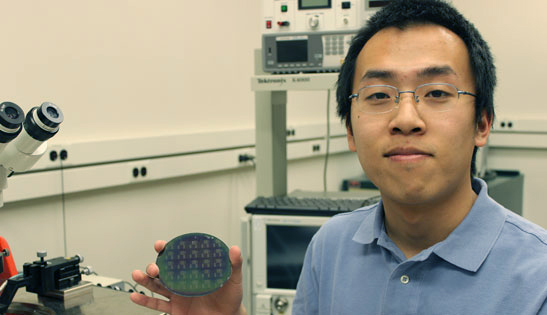MEMS research by Muzhi Wang recognized at IMS 2014
The paper reports on the design, fabrication, and results of a directly heated phase change RF switch using germanium telluride.

 Enlarge
Enlarge
ECE graduate student Muzhi Wang received a best student paper award, honorable mention, at the 2014 IEEE International Microwave Symposium (IMS2014) for his research in RF MEMS switches for high-power RF applications.
The paper, “Directly heated four-terminal phase change switches,” co-authored by Muzhi’s advisor, Prof. Mina Rais-Zadeh, reports on the design, fabrication, and measured results of a directly heated phase change RF switch using germanium telluride (GeTe) in a four-terminal configuration.
Phase change or resistance change materials, such as GeTe, exhibit two distinct resistivity values, different by several orders of magnitude, when they transition between the crystalline and amorphous states. Compared to switches using other solid-state or MEMS technologies, phase change switches (a.k.a. vias) offer smaller loss for a similar switch size with competitive linearity and power handling capability. Recent research also demonstrated phase change switches with incredibly high power handling capability and good linearity, making them a strong candidate for high-power RF applications.

 Enlarge
Enlarge
The main challenge with designing phase change switches is to achieve good power handling and low power consumption at the same time. Muzhi presented a new directly heated four-terminal switch architecture consisting of two RF ports (input and output) and a separate path for the heater, allowing the bias current to go through the GeTe layer to obtain the desired temperature. This design offers higher power handling capability with significantly lower power consumption compared to indirectly heated switches.
The paper was recognized as one of the top 10 papers presented at the IMS 2014 conference, which is the flagship conference of the IEEE Microwave Theory and Techniques Society (MTT-S). Members of MTT-S are engaged in research, development, design, or manufacturing of high frequency materials, devices, circuits, components, or systems. The IEEE MTT-S International Microwave Symposium (IMS) is the premier annual international meeting for technologists involved in all aspects of microwave theory and practice.
 MENU
MENU